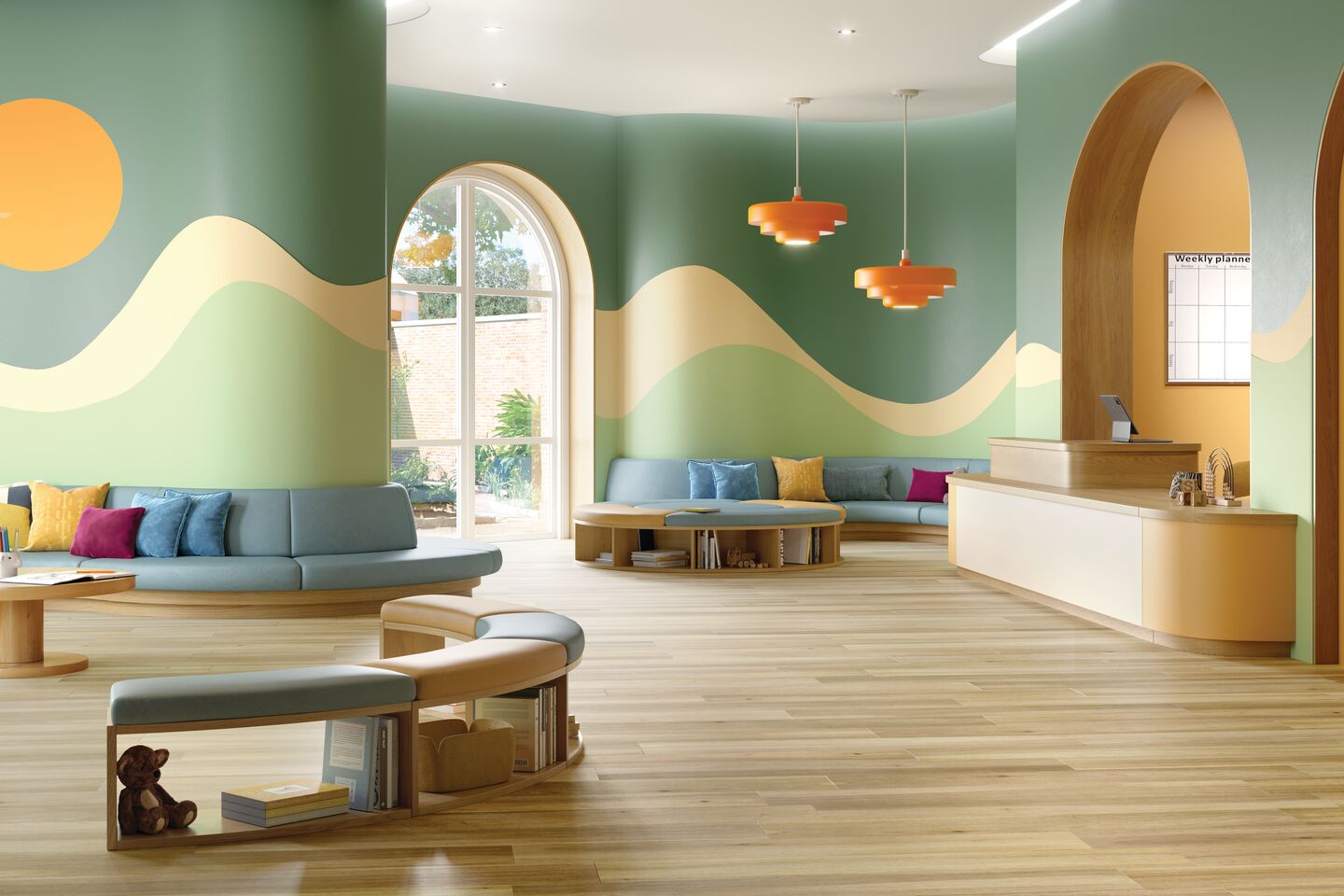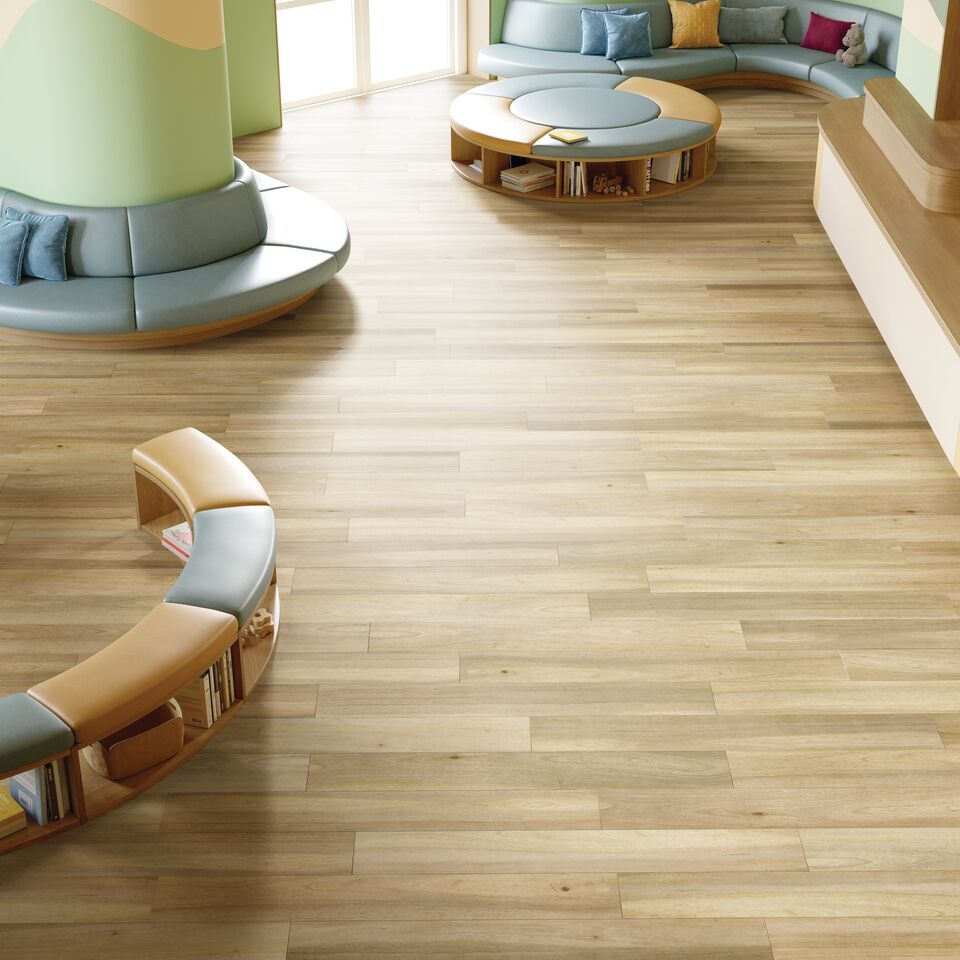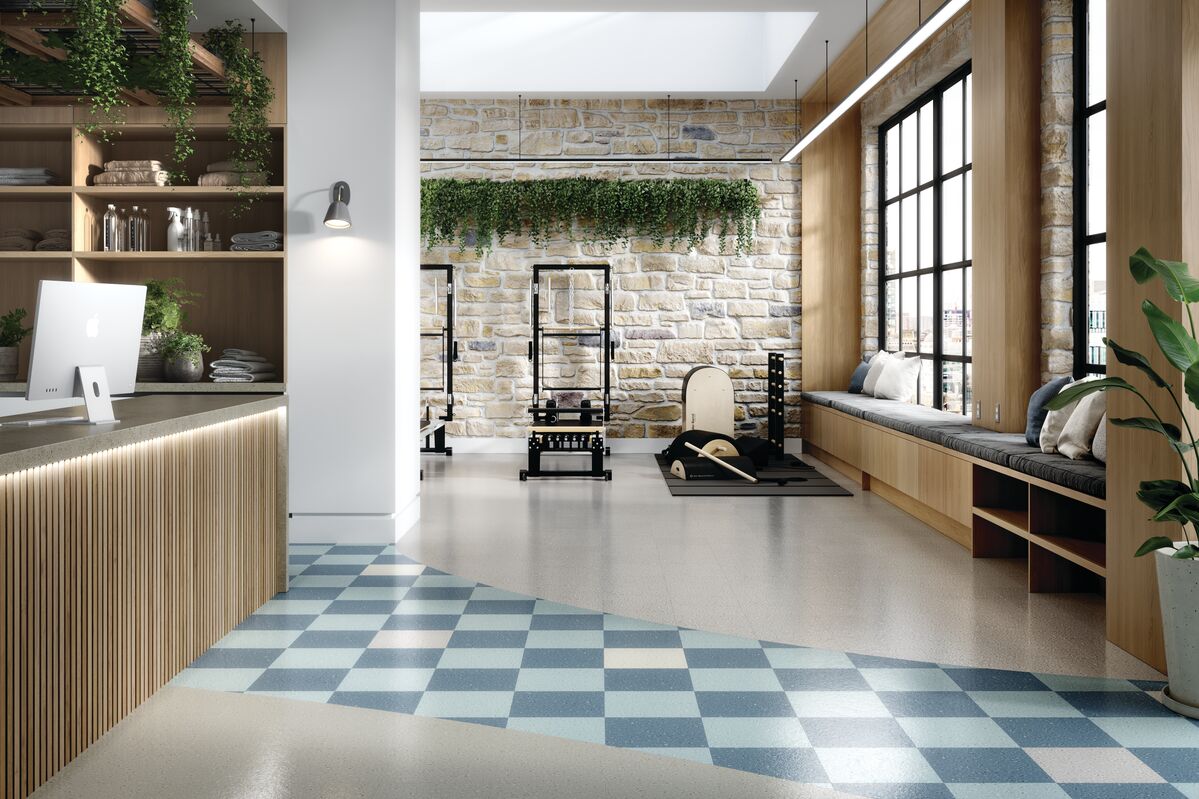Healthcare Interior Design: From Clinical to Human-Centered
By AHF™ | AHF® Contract Flooring Experts
September 19, 2025
In today’s rapidly evolving healthcare landscape, healthcare interior design has become more than a matter of form or finish. It’s now a strategic tool for improving care, supporting staff, and shaping better health outcomes.
For designers, facility managers, and project managers, staying on top of design trends isn’t just about aesthetics. It’s about creating environments that balance functionality, flexibility, and the human experience, while also meeting operational and sustainability goals.

Key Takeaways
Healthcare interior design is shifting fast, with six major trends leading the way:
- From clinical to healing environments
- Biophilic and nature-connected spaces
- Flexible, future-ready interiors
- Supporting the people who deliver care
- Safety balanced with sensory comfort
- Sustainability as a baseline expectation
For commercial project teams, these priorities aren’t abstract. They’re shaping construction projects, specifications, and long-term investment decisions.
| Trend | What It Means | Commercial Implication |
| Healing Environments | From clinical to comforting | Specify materials that reduce stress and improve patient experience |
| Biophilic Design | Nature as therapy | Use sustainable, natural visuals to reinforce wellness |
| Flexible Interiors | Spaces that adapt | Modular systems minimize downtime and extend facility lifespan |
| Supporting Caregivers | Design for staff well-being | Ergonomic, acoustic, and restorative design reduces turnover costs |
| Safety Meets Sensory | Infection control + comfort | Matte, seamless materials balance hygiene and emotional safety |
| Sustainability | Low impact is baseline | Products must meet environmental certifications and lifecycle performance |
Why Healthcare Design Matters More Than Ever
The pandemic amplified what many healthcare professionals already knew: environments impact care. Poor acoustics or sterile settings aren’t just unpleasant—they can increase stress, delay recovery, and reduce staff performance.
On the other hand, thoughtful, human-centered design—rooted in research and responsive to real needs—can:
- Reduce patient anxiety
- Improve infection control
- Enhance staff well-being
- Increase operational efficiency
“We’re seeing healthcare design move from reactive to proactive,” says Oxana Dallas, Commercial Product Designer at AHF™ Products. “It’s about designing environments that actively support health.”
In this shift, design thinking in healthcare is no longer optional—it’s essential.
1. From Institutions to Healing Environments
One of the most visible shifts in modern healthcare interior design is the move away from cold, clinical spaces toward warm, welcoming environments that feel more like home than hospital.
This isn’t about aesthetics for aesthetics’ sake. It’s about applying evidence-based design to support mental and emotional health—especially in long-term care, behavioral health, and pediatric settings.
According to global research by WGSN Interiors, 65% of people now define being healthy as being in good mental and emotional health, not just physical condition.
Where it shows up: residential-inspired lighting, acoustic ceiling systems, artwork programs, and flooring, materials that are quiet, soft underfoot, and home-like in appearance help create an atmosphere of dignity and calm.
2. Biophilic and Nature-Connected Spaces
The connection between nature and health is well-documented. Increasingly, it’s central to healthcare design strategies.
According to an article in the National Library of Medicine, exposure to natural elements in healthcare environments correlates with reduced stress, shorter recovery times, and better patient satisfaction (NLM).
How it’s implemented:
- Living walls and interior gardens
- Daylight-maximizing layouts
- Organic textures and natural material palettes
For example, flooring with textured visuals like stone, bamboo, or warm wood helps reinforce biophilic narratives. AHF® Contract embraces this approach with collections like, which taps directly into the science of biophilia with its wood-look visuals.
When paired with sustainable materials and low-VOC adhesives, these solutions also support long-term environmental goals.

3. Flexible, Future-Ready Interiors
Across medical construction and design, adaptability has become a core requirement.
According to Health Facilities Management Magazine, hospitals are increasingly using prefabrication and modular construction to shorten timelines, improve quality, and limit disruption—especially for patient rooms, labs, and observation units (HFM Magazine).
Design leaders are also prioritizing future-proofing: movable partitions, standardized room modules, and building systems that facility managers can reconfigure as services evolve. Flexibility is now a top planning and delivery priority (Robins & Morton).
With flooring, modular formats like click-tile LVT, carpet tile, and resilient sheet goods allow zones to be updated or repaired quickly, often without shutting down entire units. They also support wayfinding through pattern and contrast while minimizing downtime.
“We’re designing flooring that keeps pace with changing use cases,” says Dallas. “That means more systems that are easy to update.”
4. Supporting the People Who Deliver Care
Healthcare design is increasingly focused not only on patients but also on the professionals who care for them.
According to the CDC’s National Institute for Occupational Safety and Health (NIOSH), nearly half of U.S. health workers reported burnout in 2022 (CDC Vital Signs).
To address this, modern healthcare interiors are incorporating:
- Daylight access
- Quiet break areas
- Acoustic buffering at nurse stations
Cushioned underfoot materials and soft visual patterns can reduce fatigue and stress—small design interventions that support comfort and long-term staff performance.
5. Safety Meets Sensory
Cleanability and infection control remain essential, but they can’t come at the expense of sensory comfort. This is especially true in behavioral health and memory care, where overstimulating surfaces or reflective finishes can trigger anxiety or agitation.
The U.S. Department of Veterans Affairs mental health design guide recommends matte flooring finishes, glare control, and defined visual contrast between floors and walls to improve safety and wayfinding (VA Design Guide).
Smooth, matte, seamless flooring installations—like heat-welded vinyl—deliver hygienic performance without visual harshness. Products like Concepts of Landscape™ sheet vinyl combine wood and stone visuals with seamless installation for infection control and muted sensory impact.

6. Sustainability as a Built-In Expectation
Sustainability is no longer a differentiator—it’s a baseline.
According to Practice Greenhealth, U.S. hospitals generate more than 5 million tons of waste annually, averaging 29 pounds per staffed bed every day (Practice Greenhealth). That scale makes material choices—including flooring—critical in long-term waste reduction.
Commercial buyers also factor in consumer pressure. A McKinsey & NielsenIQ study found that products marketed with sustainability or health claims grew 40% faster than products without such claims (McKinsey).
AHF Contract delivers solutions that meet rising standards, including EPDs, HPDs, and FloorScore® certifications.
Products like Iliad® VCT reduce carbon footprint by using 85% locally sourced North American limestone. With through-color construction and a 20–30 year lifespan, less material ends up in landfills.
“Sustainable materials are part of the design brief from day one,” says Dallas. “Specifiers want performance, comfort, and low impact—and we’re delivering all three.”
Building Better with AHF® Contract
For the commercial market, healthcare design is about more than finishes—it’s about value, resilience, and outcomes. Every decision made in medical construction and design today shapes healthcare environments for decades.
That’s why AHF Contract partners with healthcare professionals, interior designers, and facility managers to deliver flooring solutions that align with these trends: flexible, sustainable, evidence-based, and human-centered.
Whether your next project involves long-term care, outpatient clinics, or behavioral health, flooring is more than a surface. It’s part of the infrastructure of healing. With the right materials strategy, you can create healthcare environments that deliver comfort, performance, and sustainability for the long term.
Call 1.866.243.2726 or find a rep near you to explore flooring solutions designed to improve the human experience in your facility.
